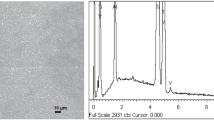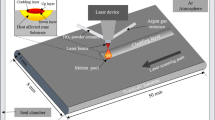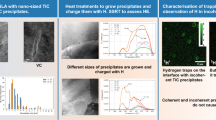The surface layer obtained by ion-beam stirring of a thin carbon film deposited on titanium alloy VT6 is studied. The composition and the chemical condition of elements in the surface layer are determined. Formation of a disordered carbon structure in a thin surface layer (20 – 40 nm) and of titanium carbides in the transition layer is detected. A model of formation of structure in the specimens during irradiation is developed. It is shown that formation of a disordered carbon structure, of titanium carbides, and of dislocation substructures is responsible for elevation of the microhardness of the specimens after ion-beam stirring.









Similar content being viewed by others
References
B. A. Kalin, N. V. Volkov, and I. B. Oleinikov, “Stirring in multilayer films and alloying of near-surface layers of polycrystalline substrates under the impact of ion beams with wide energy spectrum,” Izv. Ross. Akad. Nauk, Ser. Fiz., 76(6), 771 – 776 (2012).
F. F. Komarov, V. M. Konstantinov, A. V. Kovalchuk, et al., “The effect of steel substrate pre-hardening on structural, mechanical, and tribological properties of magnetron sputtered TiN and AlN coatings,” Wear, 352 – 353, 92 – 101 (2016).
I. V. Ivanov, A. Thoemmes, V. Yu. Skiba, et al., “Effect of the power density of electron beam on the structure of titanium under out-of-vacuum electron-beam treatment,” Metalloved. Term. Obrab. Met., No. 10, 10 – 17 (2018).
J. Mackerle, “Coatings and surface modification technologies: a finite element bibliography (1995 – 2005),” Model. Simul. Mater. Sci. Eng., No. 13, 935 – 979 (2005) (doi: https://doi.org/10.1088/0965-0393/13/6/011).
V. I. Kalita, D. I. Komlev, G. A. Pribytkov, et al., “Structure, phase composition and microhardness of a plasma cermet TiC – Ti coating,” Fiz. Khim. Obrab. Mater., No. 3, 16 – 28 (2018).
A. Rajabi, M. J. Ghazali, and A. R. Daud, “Chemical composition, microstructure and sintering temperature modifications on mechanical properties of TiC-based cermet — A Review,” Mater. Design, 67, 46 – 95 (2915).
R. Hauert and J. Patscheilder, “From alloying to nanocomposites — improved performance of hard coatings,” Adv. Eng. Mater., 2(5), 247 – 259 (2000).
N. P. D’yakonova, E. V. Shelekhov, T. A. Sviridova, and A. A. Reznikov, “Quantitative x-ray phase analysis of weakly textured objects,” Zavod. Lab., 63(10), 17 – 24 (1997).
G. A. Dorofeev, A. N. Streletskii, I. V. Povstugar, et al., “Determination of the sizes of nanoparticles of x-ray diffractometry,” Kolloid. Zh., 74, 710 – 720 (2012)
C. D. Wagner, W. M. Rigus, and L. E. Davis, Handbook of X-Ray Photoelectron Spectroscopy, Physical Electronics Div., Perkin-Elmer Corp., Eden Prairie (1979).
A. C. Ferrari and J. Robertson, “Raman spectroscopy of amorphous, nanostructured, diamond-like carbon, and nanodiamond.,” Phil. Trans. R. Soc. London, A362, 2477 – 2512 (2004).
A. P. Gulyaev, Metal Science [in Russian], Metallurgiya, Moscow (1986), 544 p.
I. A. Kuzina, E. V. Kozlov, and Yu. P. Sharkeev, Gradient Surface Layers Based on Intermetallic Particles [in Russian], Izd. NTL, Tomsk (2013), 260 p.
L. Lindsay and D. A. Broido, “Optimized Tersoff and Brenner empirical potential parameters for lattice dynamics and phonon thermal transport in carbon nanotubes and graphene,” Phys. Rev. B, 81, 205441 (2010).
J. F. Zeigler, J. P. Biersack, and U. Littmark, The Stopping and Range of Ions in Solids, Pergamon, New York (1985), 321 p.
F. F. Komarov, A. P. Novikov, and A. F. Burenkov, Ion Implantation [in Russian], Izd. “Universitetskoe,” Minsk (1994), 303 p.
V. P. Voloshin and Yu. I. Naberukhin, “On the origin of splitting of second maximum in the radial distribution function of amorphous solids,” Zh. Strukt. Khim., 38(1), 78 – 88 (1997).
Author information
Authors and Affiliations
Corresponding author
Additional information
Translated from Metallovedenie i Termicheskaya Obrabotka Metallov, No. 2, pp. 20 – 25, February, 2021.
Rights and permissions
About this article
Cite this article
Sozonova, N.M., Vorob’ev, V.L., Gil’mutdinov, F.Z. et al. Investigation of Surface Layers of Titanium Alloy VT6 with Deposited Carbon Film under Ion-Beam Stirring. Met Sci Heat Treat 63, 80–85 (2021). https://doi.org/10.1007/s11041-021-00650-4
Published:
Issue Date:
DOI: https://doi.org/10.1007/s11041-021-00650-4




